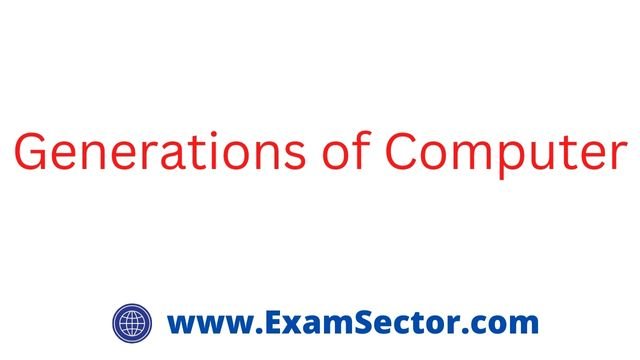Generations of Computer
- In Computer language, “Generation” is a set of Technology. It provides a frameworkfor the growth of the computer technology. There are totally Five Computer Generations till today. Discussed as following.
First Generation:-
- Duration: 1942-1955
- Technology: vacuum tube
o Used as a calculating device.
o Performed calculations in milliseconds.
o To bulky in size & complex design.
o Required large room to place it.
o Generates too much heat & burnt.
o Required continuously hardware maintenance.
o Generates much heat so must air-conditioner rooms are required.
o Commercial production is difficult & costly.
o Difficult to configure.
o Limited commercial use.
o ENIAC, EDVAC, EDSAC are example of 1st generation computer.
Second Generation:-
- Duration: 1955-1964
- Technology: transistor
o 10 times Smaller in size than 1st generation system.
o Less heat than 1st generation computers.
o Consumed less power than 1st generation system.
o Computers were done calculations in microseconds.
o Air-conditioner is also required.
o Easy to configure than 1st generation computers.
o More reliable in information.
o Wider commercial use.
o Large & fast primary/secondary storage than 1st generation computers.
Third Generation:
- Duration: 1965-1975
- Technology: IC chip
o Smaller in size than 1st & 2nd generation computers.
o Perform more fast calculations than 2nd generation systems.
o Large & fast primary/secondary storage than 2nd generation computers.
o Air –conditioner is required.
o Widely used for commercial applications.
o General purpose computers.
o High level languages like COBOL & FORTAN are allowed to write programs.
o Generate less heat & consumed less power than 2nd generation computer.
Fourth Generation:
- Duration: 1975-1989
- Technology: Microprocessor chip
o Based on LSI & VLSI microprocessor chip.
o Smaller in size.
o Much faster than previous generations.
o Minimum hardware maintenance is required.
o Very reliable as computer to previous generation computers.
o Totally general purpose computer.
o Easy to configure.
o Possible to use network concept to connect the computer together.
o NO requirement of air-conditioners.
o Cheapest in price.
Fifth Generation:
- Duration: 1989 to Present
- Technology: ULSI microprocessor chip
o Much smaller & handy.
o Based on the ULSI chip which contains 100 million electronic components.
o The speed of the operations is increased.
o Consumed less power.
o Air-conditioner is not required.
o More user friendly interface with multi-media features.
o High level languages are allowed to write programs.
o Larger & faster primary/secondary storage than previous generations.
o Notebook computers are the example of 5th generation computers.
Latest Computer Post :- Click Here
Basic Computer Questions
Q : The main system board of the computer is called ____.
(A) Motherboard
(B) Processor
(C) Microchip
(D) None of these
Click to show/hide
Q : Which of the following system components is the brain of a computer?
(A) Circuit board
(B) CPU
(C) Memory
(D) Network card
Click to show/hide
Q : What is the built-in permanent memory in a computer called?
(A) RAM
(B) ROM
(C) CPU
(D) CD-ROM
Click to show/hide
Q : Which of the following is the full form of NTFS?
(A) New Tree File system
(B) New Technology file system
(C) New Table file system
(D) Both B and C
Click to show/hide
Q : Which of the following is not a hardware processing chip ?
(A) Processing chip
(B) printer
(C) mouse
(D) Java
Click to show/hide
Q : The monitor of a computer is-
(A) storage device
(B) processing device
(C) input device
(D) output device
Click to show/hide
Q : Which protocol does Ping use?
(A) TCP
(B) ARP
(C) ICMP
(D) BootP
(E) None of these
Click to show/hide
Q : If you wish to extend the length of the network without having the signal degrade, you would use a ___.
(A) Gateway
(B) Router
(C) Modem
(D) Repeater
(E) Resonator
Click to show/hide
Q : A series of instructions that tells a computer what to do and how to do it is called a ______.
(A) program
(B) command
(C) user response
(D) processor
(E) None of these
Click to show/hide
Q : Verification of a login name and password is known as_____.
(A) Configuration
(B) Accessibility
(C) Authentication
(D) logging in
(E) None of these
Answer ⇒ ??
